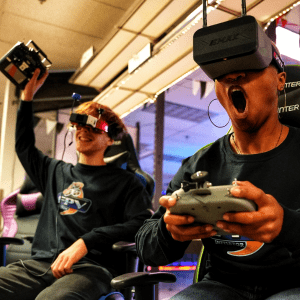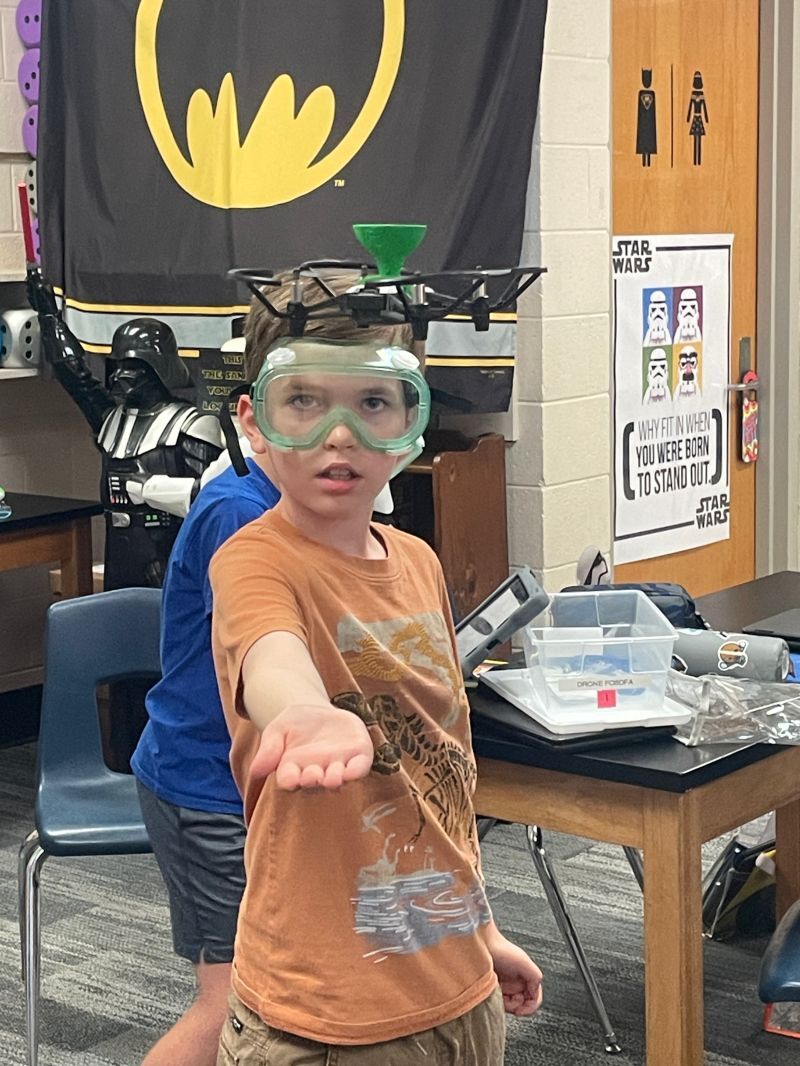Every time something “new,” “innovative,” or “high-tech” comes into the picture, the STEM community gets excited. Whenever we have an opportunity to facilitate hands-on learning experiences, it’s a good day. Here’s a general timeline of drones in education:
- 2014 – Recreational drones were on the market and sometimes used on sports fields for out-of-class learning experiences, specifically focused on math and engineering for upper grades.
- 2015 – Drone technology was refined, and prices began to drop, which made drones much easier for schools to get their hands on, albeit with low adoption rates at first.
- 2016-2017 – Drones in education launched (pun intended) worldwide, with college research departments, business development clubs, and more using them on a more regular basis.
- 2018 – Drones started showing up as a regularly featured part of education technology (edtech), and were increasingly used both outdoors and indoors, especially as they became safer.
- 2019 – Drones were firmly established as a key way to teach kids grades K-12 important STEM skills, especially targeted for computer programming, photography, and STEM career prep.
- 2020-2021 – Drones in schools are everywhere: older students are getting FAA certifications, robotics students are building their own drones, and kids as young as kindergarten are using drone STEM curriculum (like Drone Legends) to program and operate drones.
Outside of education, drones have been readily and thoroughly assimilated into operations for industries from real estate to medicine to supply chain management.
For school administrators and educators, a point that must be proven not just once but over and over again is that drones are safe for the classroom. Regulatory agencies have recognized the importance of confirming this, and all of the major players worldwide have created guidelines.
Drone Regulations by Region
Drone Legends has customers all over the world. We thought it would be helpful to assemble an overview of regional drone regulations, as well as resources that will help you learn the guidelines around operating drones in your classroom or educational facility.
FAA: Unmanned Aircraft Systems (UAS)
In the good ole’ US of A, the Federal Aviation Administration (FAA) regulates unmanned aircraft systems (UAS), which means drones. Through this agency, people can become certified to operate drones either recreationally or commercially. There are some standards around how high a drone can fly into the air and what times of day it can be flown.
Specific FAA regulations are supplied for educational users, which is a tip that the U.S. gov realizes that drones can be used in the classroom, as long as they’re used safely. Part 107 is the main law that addresses flying drones that are under 55 pounds. It takes three steps to fly under Part 107 rules: read the rules, (yes, for real), become an FAA-certified drone pilot (pass a test), register your drone with the FAA.
Under an amended statutory provision (P.L. 115-254), educational institutions can fly drones under the rules for recreational flyers. Those rules are:
- You only fly for recreational purposes.
- You follow the safety guidelines of existing aeromodeling organizations, or use the Advisory Circular standards.
- You keep your drone in visual line of sight, or have someone next to you who can see it.
- You don’t give away your drone or interfere with any manned aircraft (as long as there aren’t planes flying through your classroom, you’re good here).
- You fly at or below 400 feet (again, no problem in a classroom).
- You have taken the Recreational UAS Safety Test.
- You have a current registration (and proof) for your drone.
- You don’t operate your drone dangerously.
The FAA website has a wealth of resources, many of which are linked above, for you to better understand what you can and can’t do, but most fall well within common sense rules for general safety.
Civil Drones: EASA and EU Regulations
The European Union Aviation Safety Agency has two regulations that address safe operation of civil drones (civil = non-military, not just polite). Here’s what those regulations are:
- Easy Access Rules for Unmanned Aircraft Systems (Regulation (EU) 2019/947 and Regulation (EU) 2019/945)
- Commission Delegated Regulation (EU) 2019/945
Here are the basics of what those regulations say:
- Drones can operate in an “open category” if they are less than 55 pounds.
- Remote pilots must maintain a visual line of sight.
- You cannot operate a drone above 400 feet.
- Drones cannot carry dangerous goods or drop materials.
- You cannot operate a drone directly over people.
- Drones must be registered with the NAA, with registration and proof.
In Europe, newer drones have class identification labels, which are in the “open category” if they are categorized as 0, 1, 2, 3, or 4. Member states do have specific subcategories, so if you are in one of those, you will need to dig a little deeper to make sure there aren’t additional guidelines to follow.
Drone Laws in South Africa: SACAA
The South African Civil Aviation Authority (SACAA) regulates drones in South Africa.
Drones for private or public use are subject to the following rules:
- The drone must be operated in visual line of sight at all times.
- You must operate a drone in a safe manner at all times.
- The aircraft must be inspected before flight.
- Outdoors, drones must be flown in the daytime only.
- Drones bigger than 15 pounds must be approved by the SACAA.
- Drones can never be flown in controlled, restricted, or prohibited airspace.
- Recreational drones cannot fly higher than 150 feet.
Drone Rules: Civil Aviation Safety Authority (CASA) in Australia
In Australia, the Civil Aviation Safety Authority (CASA) regulates the use of recreational drones. Their rules are going to sound familiar, and here is what drone operations in Australia need to know:
- Drones cannot fly higher than 400 feet.
- Only one drone should be flown at a time.
- You cannot record or photograph people from a drone without their consent.
- Drones should not fly over populous areas, including sport ovals, beaches, parks, or other events.
- You must keep a drone in your visual line of sight at all times.
- If a drone weighs more than half a pound or so, it must fly about 3.5 miles away from airports.
- You cannot operate in a drone in a way that creates a hazard for another person or property.
For drones over 55 pounds, you will need to obtain a remotely piloted aircraft operator’s certificate (ReOC).
Using Drones for Education
You may think, after reading that list, “I have enough red tape in my life.” First: regulations are in place, but any good drone curriculum will align with the maximum safety standards to keep kids protected (meaning, all the work of implementing best practices is done for you). Second: there are pretty compelling reasons why the effort of using drones in the classroom is worth it.
Drone Educational Users
The FAA acknowledges that “Drones (and model aircraft) are great tools for use in education.” Drones can, and are, being used to support the full scope of STEAM learning:
Science and drones — Drones are being used everyday worldwide to support the cause of science, like the ones being used to monitor rivers or perform geoscientific research. For kids, the physics behind drones is a powerful science learning opportunity. Physical science at every level is on display as kids observe the way drones are operated, and how they adhere to the laws of nature.
Technology and drones — Kids will get to see the relevance of drones and the future of technology every day, as drones are used to manage farms, deliver packages, in search and rescue missions, for firefighting, and even for monitoring traffic. Interacting with sophisticated technology, that comes with a reference guide in the form of our Operational Manual, is a great way to introduce kids to new kinds of tech.
Engineering and drones — Pretty straightforward: drones are engineered machines. They are built using an engineering design process and contain mechanisms that perform different functions. Everything about a drone is an illustration of a foundational engineering concept, and the process of planning and executing missions (the using of drones) supports valuable critical thinking skills and problem-solving skills.
Art and drones — Drones got their popular start in videography, and art is an essential component of a comprehensive STEM education. We’ve seen some of our Drone Legends go on to create videography businesses, using drones to create and edit movies. Aerial drone photography and videography is a growing field, and one that offers learners of all ages an opportunity to express themselves.
Math and drones — Drones make math fun, and that includes math of all kinds: geometry, numbers, algebra, you name it — calculations are an inherent part of making a drone function. This is a great opportunity to get even the kids who “don’t like math” in on the fun, because they need to flex those computational abilities to get the drone off the ground.
Drone Safety Standards From Drone Legends
At Drone Legends, we are safety-first kinds of people, especially when it comes to kids. You can be assured that our curriculum and every drone mission is built with kids’ safety in mind. Our standards-aligned STEM curriculum books guide children through problem-solving adventures, teaching them how to code and operate drones. We have safety recommendations every step of the way, with built-in checkpoints to ensure every user knows what they need to do to offer optimal protection.
Here is a handy checklist to keep drones in the classroom safe:
- Be sure you have a drone that is approved for use in your classroom or facility.
- Have a designated operator to oversee the drone at all times.
- Maintain a visual line of sight at all times.
- Be sure all regular classroom safety practices are in place, such as making sure nothing heavy is stacked very high or that there are hazards present.
- Don’t leave students alone with drones in the classroom.
- Be sure students understand how to operate drones and are taught before they try.
- Keep drones charged (using the correct chargers) and use bumpers on all tablets or other equipment.
FAQs About Classroom Drone Safety
Here are a few answers to frequently asked questions about classroom drone safety. We’ll use U.S. standards to answer these questions, but most of what we will relay here applies in any area of the world.
How Can Drones be Used in a Classroom?
Drones are used in classrooms around the world to reinforce STEM learning. Drone clubs in school, drone classes in school, drone afterschool enrichment programs, and more are being offered in virtually every location globally. This is because drones are fun and they are an immensely useful tool for capturing the imagination of elementary school age learners (plus junior highers, plus highschoolers, plus college students, plus adults, you get the idea).
Can Drones be Flown Over Schools?
Regulations vary depending on where you live. Drones flying over the schools are generally not allowed, which is a good thing for security and privacy reasons. Drones flying in schools is a totally different point of consideration. The drones used for education are exceedingly light: nothing like the heavy-duty ones used for commercial or industrial purposes. When aligned with regulatory guidelines, drones can offer students with great hands-on learning experiences.
What are the Risks of Drones?
Drones present a few risks in the world at large: they can compromise privacy or even injure someone if flown recklessly. All of the national or countrywide standards set in place by regulatory agencies aim to mitigate this risk, ensuring that people who fly drones for recreational purposes do no harm. The risk of drones in the classroom could be something getting knocked over, or someone getting bumped. Drones that are approved from classroom use are light enough to do very little harm even if that happens. When drones are flown in the classroom, they must be lightweight and children may need to use goggles or other protective elements to keep them totally safe.
Drones in Class are Here to Stay
Drones in class are here to stay. Educators have seen the value of using drones to teach STEM skills, bring kids together, enhance enrichment programs, and more. When operated in accordance with regulatory guidelines, there is very little risk of drones ever causing harm. As with anything, be sure you do it right, and it’ll have a ton of great rewards.




